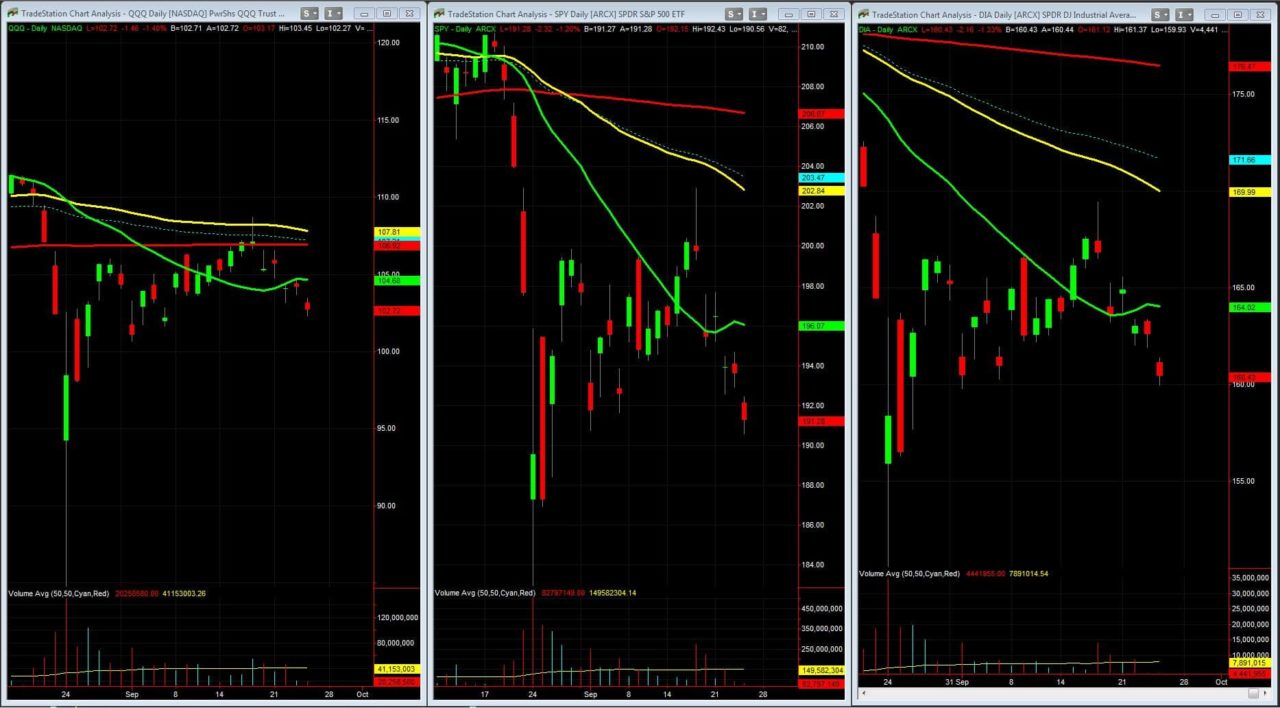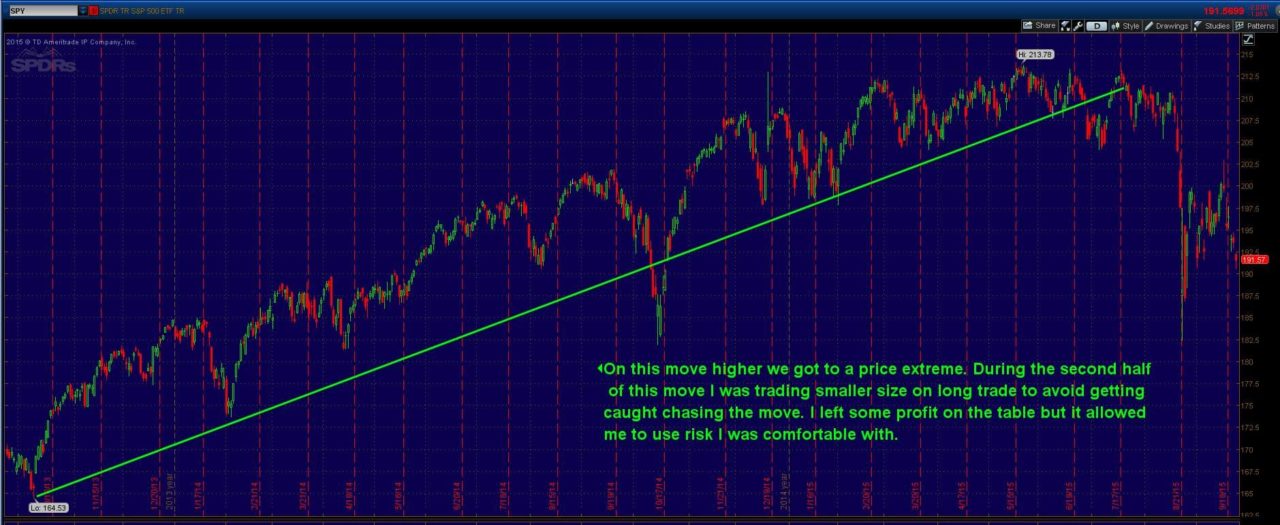One of the topics that comes up quite often with our Options Mastery students has to do with knowing what type of position size to use when placing trades. Whether you are swing trading or day trading this topic is always a tricky one. Many courses and instructors encourage using a fixed percent of account size approach working 24/7. A common rule for day traders is to not risk more than 2% of your overall account size on each trade. For swing traders, it is a little different because in many cases they are trading multiple stocks/ETF’s. So does that same 2% rule apply to swing trading? I actually like to take a different approach in my own trading which we will walk through below. The key to position sizing is to make sure your plan fits your own risk tolerance. A major issue with the 2% rule is that everyone is a little different when it comes to risk tolerance. I like to custom build a plan for my students that fits what they are looking to accomplish with their trading. You must have a plan with simple day trading strategies in place that you stay disciplined to or the emotional aspect of trading will take over and you will end up over trading.
Over time, I started to realize that using the 2% risk per trade didn’t fit my trading plan or risk tolerance. So I started to experiment with some different approaches that would better fit me as a trader. There were a few important areas that I needed to address. I wanted to have a rule built into the plan that would allow me to adjust my risk over time. What I mean here, is I wanted to be able to adjust my position size depending on how aggressive or conservative I was looking to be. This did a few things for me. Over time, I have been able to increase my overall returns by getting more aggressive during big market moves and more conservative during slow market conditions. Second, it allowed me to put some of my personal opinions of where I thought the market was going into my trading. This gave me the flexibility that I was looking for while still being able to stay disciplined to my plan. You can use apps to get started with investing. There are plenty of great options. Here’s a list of some of the best ones https://daytradereview.com/best-stock-trading-apps/.
Let’s go ahead and walk through a template that I like to use in my own trading. Keep in mind this plan is designed for my personal trading style which is focused on swing trading Options on stocks and ETF’s.
Sample Risk Template:
- Determine what % of your account size you are willing to have at risk.
In my plan I use the 50% number. This rule says I will not have more than 50% of my account size at risk at any one time. If I am using a $50,000 account this means across all my different positions I can’t have more than $25,000 at risk. So I have $25,000 to work with spread across the 22 names on my watch list. If I reach that $25,000 limit and I get new trades to set up, then I need to either close out of some existing trades to free up capital in order to get back below the $25,000 level or skip the trade. The 50% number works for me and is a level I am comfortable with. That number could be different for you. It could be 25% or 60%. The number doesn’t matter to me as long as you are comfortable with that level of risk and it’s something you can stay disciplined to following.
- Use the Charts to overweight certain areas of your Watchlist.
In today’s market environment, it I think it is very important to have a rule in place that will allow you adjust your risk depending on which areas of the market are moving. For example, in a stock picker’s market you might see different stocks or even sectors get very active while others are slow. If we see financial names get very active leading the market back and forth while energy names are stuck in a slow sideways move, then we will want to get more aggressive with the financials while cutting back on the energy names. How do we know when to make a move like this? We preach to our students to identify a watchlist of stocks/ETF’s to look at and then stick with that list for an extended stretch. This will build a comfort level with those products to the point where you can tell when conditions are changing. Pulling up a random stock off a stock scan each night does not allow you to trade with the same confidence that you would if you are trading the same names on a daily basis. The key to building a watchlist is to make sure you are diversified. If your list is full of financials or tech names, then there will be too much overlap leading to being over exposed in one area. You might think you are using good risk rules but if all that risk is in one sector then you are leaving yourself open to wild swings in your equity curve. Instead, make sure you have a mix of stocks and ETF’s as well as a number of different sectors included (financials, tech, energy, retail, emerging markets, commodities, index, and volatility products).
- Use the Market Overview charts to form an opinion on overall market direction.
This is something that I have started to use over the past few years and it has really paid off. I use the 3 major U.S. index ETF’s (SPY, QQQ, DIA) as my overview charts. I look at these 3 on daily charts with the 20, 50 and 200 period simple moving averages added. I also plot the 89 period exponential moving average. Finally, I look at a basic volume indicator at the bottom of each chart. These charts help me form an opinion of where the overall market has been and where it potentially could be headed going forward. If I see the overall market make a big move higher and reach a price extreme on the upside, then I will start to reduce my size on any long trades. On the flipside, if we see a market make a price extreme on the downside I will reduce my risk on any new short trades. This is an attempt to not get in late and chase big moves after a good portion of the move has already happened. In many cases, if a big trend develops we will have already booked nice gains on the early part of the move. I have found the odds of success go down the later in the move that we get. By having a bias in one direction or the other like this, you will find times where you leave profit on the table by taking smaller trades late in a trend. However, over time by adjusting risk my overall equity growth has really improved.
- Have a rule to stop trading when you break your trade plan.
While this might seem off topic when it comes to position sizing, it is crucial to your long term success. The only way a trade plan will work is if you put rules in place that you can stick too. I have rules built in that cause me to take a break from trading for a few days if I break my plan. If I don’t stick to my 50% risk rule that we talked about earlier, then I know it’s time to get away from trading for a few days. If I don’t take the proper trades according to my Active Swing Trader system that I use, then I know it’s time to take a break. As a trader I am the boss, which means I have to hold myself accountable. Making money in the markets is difficult enough with a trade plan using proper position sizing. Trying to make a go without rules in place will lead to disaster at some point.
These are some of the ways that I have been able to develop my plan for position sizing in my options trading. I have found really nice success with this over the years. The language in your plan or the percentages you are using might be different but the important part is that you take the steps to put those rules in place. Using proper position size is one of the most important factors to becoming a successful trader. Don’t take another trade until your set of guidelines is in place.

